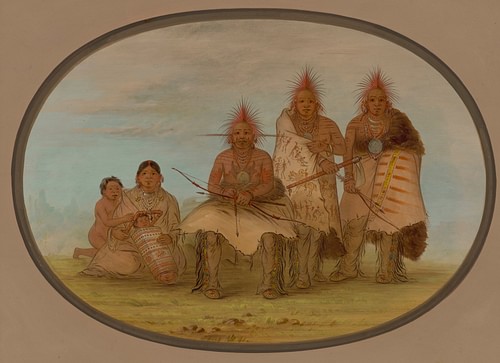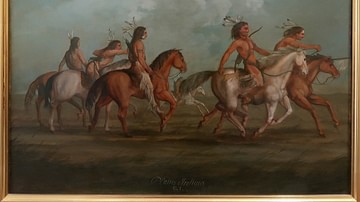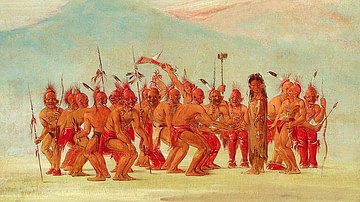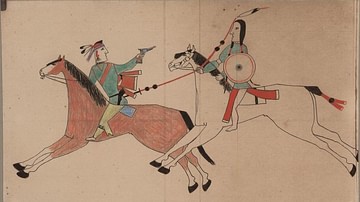
The Pawnee are a Native American nation of the Plains Indians culture originally from the region of modern Nebraska. Prior to the European colonization of the Americas, they were among the most powerful of the Plains Indian tribes numbering over 60,000, reduced to between 4,000 and 8,000 by 1859. Today, they live primarily in Oklahoma.
It is unclear when the people first inhabited their ancestral lands in Nebraska and part of Kansas, but they were initially a hunter-gatherer society moving between the regions of Oklahoma, Kansas, and Nebraska. According to the people themselves, their first ancestor was a woman born of the union of the Morning Star and Evening Star at the beginning of time, and they had always lived on the lands where the Spanish first encountered them in the 16th century and the French in the 17th.
Owing, in part, to their cosmological beliefs and religious rituals, including human sacrifice, the Pawnee were regarded with suspicion by many of the other Plains Indian nations, especially the Sioux and Cheyenne who, with their allies, regularly made war on them. After the Pawnee had mastered the horse and received European weaponry, they posed a significant challenge to the other nations and were also able to expand their hunting grounds.
The combination of European-borne diseases such as smallpox and measles – to which they had no immunity and which seem to have been transmitted by the Sioux – and attacks by the Sioux and their allies, as well as raids by the Apache, greatly reduced the population, who sought the assistance of the US government in the 19th century. Pawnee scouts and warriors regularly served with the US Army against other Plains nations and were highly regarded by the US military for their skill and loyalty.
After losing the Battle of Massacre Canyon to the Sioux in 1873, and with their already diminished numbers, the Pawnee agreed to allow their relocation to Indian Territory in modern-day Oklahoma in 1875. By 1900, there were less than 1,000 Pawnee left, but this number has increased in the last 100 years as has their political, social, and economic autonomy.
Name, Language & Nation
The name Pawnee is thought to come from the Sioux word for "horn" and refers to the practice of Pawnee warriors greasing their hair so that it rose in a curve like a horn. The Pawnee referred to themselves as Chaticksas si Chatichs, "men of men" or "the men of the men." Their traditional home was along the Loup, Platte, and Republican rivers of Nebraska, and the four bands that formed what became known as the Pawnee Confederacy spoke the Caddoan language and were further unified by religious belief but retained tribal autonomy. The four bands, one in the north and three to the south, were:
- Skidi – the northern band with the largest population, known as the "wolf people"
- Kitkehahki - who lived by the Republican River and came to be known as Republican Pawnee
- Chawi (Tsawi, Chaui) – known as the Grand Pawnee
- Piltahawiraata/Pitahaureat – known as the Downstream Pawnee

It is unclear when the Pawnee formed their federation, but the people were well-established in villages throughout Kansas and Nebraska by the time Coronado's expedition encountered them in 1541. The description Coronado gives of the kind of villages he encountered matches those of later accounts of Pawnee communities as described by scholar Adele Nozedar:
The tribe settled close to rivers and other water sources, living in thatched oval lodges made of earth, including four poles that were placed according to the four compass directions. A hole in the roof served as a chimney. These lodges were large and could house as many as fifty people. (360)
The uniformity of the villages, as well as a central authority that could mount resistance against Coronado, suggests that the Pawnee were a developed tribal nation at this time. Archaeological evidence from the region further suggests this had been the case long before the encounter with Coronado, dating to c. 1250 CE. What type of governmental and societal structure the Pawnee had at that time, however, is unknown.
Government & Daily Life
By the time the French came into contact with them in the 17th century, their government was a loose confederation of autonomous bands of villages that were self-governing. A Pawnee chief acted more as a moderator and counselor than a political authority. The Skidi band operated separately from the three southern bands but had the same social structure. Villages were made up of households who considered themselves extended family and the chief was the head of the family.
Each household had two male heads, one overseeing the north area and the other the south. The people of the household answered to the head of their area and that head answered to the chief. Decisions regarding the whole community were made by a council of the chief and the heads of the households. Women participated in these councils only insofar as the issue under discussion pertained to their sphere, such as trade or agricultural matters. Men decided on whether to wage war, criminal complaints, and the observance of religious rituals, among other matters.
Tribal cohesion was maintained by the belief that everyone in the village was a member of the same family and descended from the same sacred founder, as noted by scholar Michael G. Johnson:
Before the Euro-American influences had radically changed Pawnee culture, each village had its own origin myth. The village founder was created by a star or star group who had also provided the founder with a sacred bundle (a collection of paraphernalia such as rocks, feathers, corn ears, animal skins, etc.) which would form an altar around which the bundle's own ritual was performed. The bundle served as a source of power for good fortune and assistance for procuring food. In time, the bundle and paternal inheritance was passed on to his son, who was thus a descendant of the founder and new village chief. Since all the people of the village were regarded as the founder's descendants, they had a common origin and a common source of power. (157-158)
The Pawnee tale Making the Sacred Bundle is an origin story addressing how the people first received the bundle which was distinct from, but influenced the development of, the individual "medicine bag" that members of the community would carry. These bags were considered a source of personal power, especially for so-called "medicine men" and "medicine women", the shamans and religious authorities of the village.
Women and men had equal rights but different spheres of responsibility. Women built the lodges, tended the crops and the home, raised the children, and engaged in trade with other villages and bands. Older women primarily dealt with raising and teaching the children, but, after around the age of 7 or 8, boys were instructed in hunting and warfare by their fathers or uncles, while girls remained under the tutelage of the elder females. Young, unmarried women learned their responsibilities from their mothers, aunts, and grandmothers while young men became either hunters or warriors depending on their natural talents.

Daily life in a village revolved around the planting and harvesting of crops, repair and maintenance of homes, hunting game, fishing, and relaxation in the form of storytelling, dances, singing, and games. A popular game was chunkey (tchung-kee), played in teams with a rolling stone disc or ring and sticks (javelins) with points scored by the player who threw his stick to land closest to the stone once it stopped. Chunkey features in the popular Pawnee legend, The Girl Who Was the Ring, in which a young girl is transformed by buffalo into a chunkey-ring.
Stories were told to entertain while also relaying cultural and religious values, explaining the world, and warning of natural and supernatural threats. In the Pawnee tale of The Ghost Wife, for example, an audience is cautioned against clinging to grief following a loss and also the danger of interacting with ghosts. Religious rituals were observed regularly but varied in date or sometimes season depending on the signs received from the heavens and interpreted by the village shaman or shamans.
Hunting parties of males would usually leave a village in the morning and, depending on the season and the game available, could be gone for a day or over a week or longer. Deer, elk, panther, and small game were hunted and trapped, and, occasionally, buffalo in the years before the Pawnee encountered the horse.
After the introduction of the horse to Pawnee culture, the people hunted buffalo regularly and these animals provided them with an abundance of resources beyond simply a food source. Corn, squash, and beans were the staples of the Pawnee diet supplemented by buffalo and other game. Corn was regarded so highly that it was included in the sacred bundle and was referred to as "holy", understood as a gift from the supreme being Ti-ra'wa ("Father Above") who also provided the people with all other gifts of life.
Religion & Ritual
The Pawnee religion is defined by modern scholars as animism – the belief in the sacred nature of all things, animate and inanimate, as all things are gifted with a soul from the Father Above – but the people themselves had no term for it as it was simply their way of life. As noted by Johnson, each village had its own origin story and also its own oral 'scripture' in the form of accounts of the Supreme Being, the natural world, great heroes of the past, and the gods who manifested their power through natural occurrences including earthquake, flood, the changing of the seasons, night and day, meteors, and the alteration of the stars in the night sky. The basic form of the origin story revolved around the Morning Star, a male war god and the first created by Ti-ra'wa, who pursued the Evening Star, a female deity associated with agriculture.
The Morning Star, after overcoming a series of challenges and obstacles, mates with the unwilling Evening Star, and she gives birth to the first human, a female, who then births all of humanity. As Pawnee society was matrilineal, the firstborn female in any version of the story takes precedence even when her son is given as the central character.
Since the people understood themselves as coming from the stars, they paid special attention to celestial events, and their villages, as well as individual lodges, were constructed according to the cardinal points and the alignment of stars in a given season. Every village had an observatory oriented east-to-west which was manned by the community's religious authorities, and based upon their observations, crops were planted and harvested, war or peace was declared, the buffalo hunt was announced, and rituals were observed.

The Pawnee, unlike other Plains Indian tribes, did not practice the Sun Dance but, instead, observed the Spring Awakening Ritual which was understood as accomplishing the same purpose of revitalizing the Earth after winter and giving thanks for the gifts from the heavens.
An important, and controversial, ritual practiced by the Skidi Pawnee was the Morning Star Ceremony in which a young girl kidnapped from another tribe would be sacrificed to ensure the fertility of the earth, the health and well-being of the community, and the continuance of life in the coming year. The ceremony was intended to reenact the creation story of the Morning Star's mating with the Evening Star, who, in this ritual, gives her blood to the earth as a fertilizing and regenerative agent. Nozedar gives the form of the rite:
The [sacrifice] would generally be a young girl belonging to another tribe, captured in the winter and cared for during the months until spring. On the appointed morning, the girl was tied to a scaffold decorated with the hides of sacred animals and shot with an arrow as the morning star first appeared on the horizon. Her chest was then cut open before she was shot many more times to speed on her death, after which her body was carried toward the east and placed face-down, the blood soaking into the earth. (361)
The sacrifice of the maiden, mirroring that of the Evening Star's reluctant submission to the Morning Star, was understood to not only guarantee the fertility of the land and the community but also assure the people of victory in warfare.
The Horse, Warfare, & Massacre Canyon
The Pawnee had the horse and European weapons by the early 18th century, acquired from French traders, and these dramatically influenced their culture in many respects. The buffalo hunt now became a ritual seasonal event, and as every part of the slain animal was used, there were greater resources to draw upon in making everyday items such as moccasins, bowstrings, clothing, tools, toys for children, jewelry, ritual ornamentation, and housing. The Pawnee adopted the teepee (tipi) as temporary housing for the hunt whereas, formerly, they had always lived in permanent lodges, and the buffalo became a major food source.
Pawnee warfare also changed significantly after the acquisition and mastery of the horse as the people could now field cavalry in defense of villages or in raids on others. The Apache, who had previously had the upper hand in warfare and could raid Pawnee villages and carry off women and children as slaves at will, now found themselves victims of Pawnee raids and massacres. The Cheyenne and Sioux also experienced a shift in power as the Pawnee were able to field a force of mounted archers.
As early as c. 1800, the Pawnee recognized the westward expansion of the Euro-Americans and allied themselves with the US Army in hopes of defeating the Sioux and their allies or, at least, more ably defending themselves against raids. The Pawnee acted as scouts and trackers for the army against other tribal nations and benefited from the relationship in being regarded as "friendly Indians" by the army and white settlers. Unlike many other nations, the Pawnee did not contract European diseases from the Euro-Americans but from neighboring nations, most likely the Cheyenne, the Sioux, or both, with the resulting epidemic wiping out the majority of the people by 1859 and reducing the population to, at most, 8,000 and, more likely, less than 4,000.
By 1833, unable to fend off raids by the Sioux, the Pawnee ceded their ancestral lands in Nebraska and Kansas to the United States with the proviso that they would still have access to the buffalo hunting grounds in season. On 5 August 1873, a Pawnee hunting party of approximately 350 were ambushed by over 1,000 Sioux warriors and their allies, suffering heavy casualties. With their population reduced further, and unable to defend themselves adequately against their enemies, the Pawnee agreed to relocate to the Indian Territory of modern-day Oklahoma. The journey was difficult and resulted in the loss of many of the people.
Conclusion
The majority of the Pawnee Nation had moved to the new location by 1875 but found it inhospitable and were unable to cultivate their staple crops of corn, beans, and squash. The buffalo had been massacred en masse by white settlers and agents of the US government by 1880 in an effort to deprive the Plains Indians of their major resource so, even if the Pawnee had still been able to mount hunting parties, there were few buffalo left to hunt. With few resources, and facing starvation, the Pawnee found themselves with severely limited options in their new location.
Many male Pawnee enlisted or reenlisted in the US Army to fight the so-called Sioux Wars, especially for the Great Sioux War of 1876, but generally, the people struggled to just survive. Their form of government and social structure dismantled, and their culture and language challenged, the Pawnee as a people were on perilous ground when, in 1889, a Paiute shaman named Wovoka began preaching his vision of the Ghost Dance as the path to the return of the lands to the Indigenous Peoples and a revival of their culture.
The US government and their Indian agents saw the Ghost Dance as a serious threat to the peace and crushed it, most notably through the Wounded Knee Massacre at Pine Ridge in December 1890, but the Pawnee, who were still regarded as "friendly Indians" were allowed to continue the ritual. The ritual of the Ghost Dance helped to preserve the Pawnee culture, traditions, and language.
By 1900, there were less than 1,000 Pawnee left alive on the Oklahoma reservation, and according to Nozedar and others, the US census for that year gives only 633 (Nozedar, 361). The Pawnee refused defeat, however, and defied efforts to eradicate them, reestablishing their rights by the 1930s and fighting for recognition of their claims of unjust actions by the US government up through the 1960s. From the 1970s to the present, the Pawnee have continued to prosper and host The Pawnee Homecoming Powwow every summer (also known as The Pawnee Indian Veterans Homecoming and Powwow), welcoming members of many different nations in celebration of their respective heritage.






